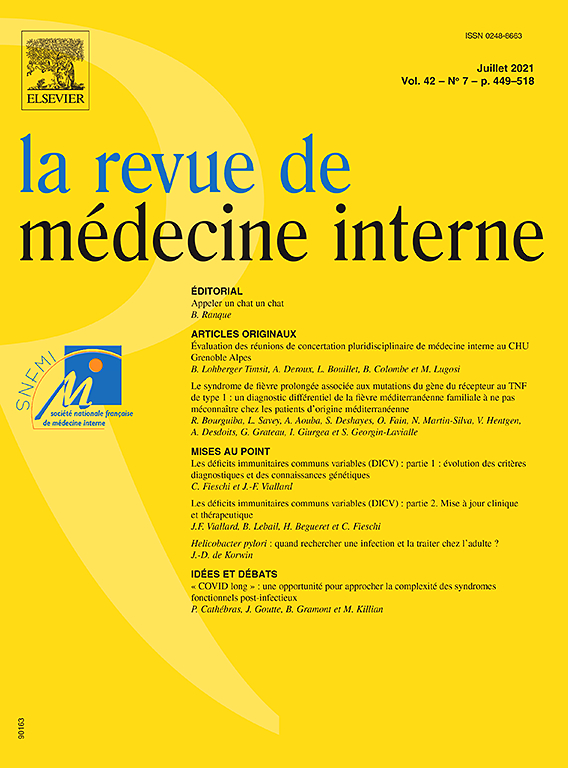Developed on meningiomas for the internal medicine review, by Julien Boetto, Michel Kalamarides, Matthieu Peyre, Marc Sanson ,.
Focus in particular on the link with progestins, and the latest ANSM recommendations.
Article here: https://www.sciencedirect.com/Science/article/pii/s0248866321005506?dgcid=AUTHOR
Extract from the article:
4. Meningiomas and hormones
4.1. Meningiomas and sex hormones
The arguments that suggest the association between sex hormones and the development of meningiomas are numerous. Meningiomas are more frequent in women with a sex-ratio all confused age of 2.3/1 whose maximum (3.15/1) is reached in women of childbearing age [1] . They tend to increase in volume during the luteal phase of the menstrual cycle, during the in vitro fertilization protocols, or during pregnancy, and to regress spontaneously during postpartum [31] , [32] . They express hormonal receptors in progesterone, estrogens and androgens in 80 %, 40 % and 40 % of cases respectively [33] . A moderate association was found between the development of breast cancer and meningiomas [34] .
Numerous studies have studied the impact of the medication of sex hormones such as oral contraception or hormonal substitute for the development of meningiomas. Currently, no formal evidence makes it possible to assert that the use of oral contraception is associated with an over-risk to develop a meningioma [35] . Indeed, no association was found between the present or past use of oral contraceptives and the risk of meningiomas.
On the other hand, taking a substitute hormonal treatment is associated with a relative risk of developing a meningiom of 1.35 (IC95 %: 1.21–1.49), the taking of progesterone being an independent risk factor of developing meningiomas in this context [36] , [37] . The predominant impact of progesterone has been confirmed by the highlighting of a significant over-risk to develop meningiomas when taking high-dose synthetic progestins such as cyproterone acetate (ACP), chlormadinone (ACC) or numestrol (4] acetate (ACN) [4] .
4.2. Synthetic meningiomas and progestin
Cyproterone acetate is a synthetic progestogen with a powerful anti-Androgenic effect, having AMM in France in the treatment of non-operable prostate cancers or paraphilies in humans, and in the treatment of hirsutism and severe hyper androgenia with a major impact on social life in women, in particular in patients presenting Polycystic (SOPK) (at a dose of 50 mg/day). It was also used out of AMM for the hormonal treatment of female transgender people, acne in connection with signs of hyperandrogenism, substitute hormonal treatment or as oral contraceptive [4] . The three main ACP action mechanisms are the competitive inhibition of testosterone receptors, the inhibition of testosterone production, and progesterone-like activity [38] .
Since 2007, many series have reported the increase in the risk of developing meningiomas during prolonged use (5 to 30 years) of high doses of progesterone acetate (25 mg - 100 mg daily) [39] , [40] . A large -scale epidemiological study made it possible to highlight a very significant increase in the risk of meningioma in women treated by ACP (Androcur) for long periods of high doses. The risk is multiplied by 7 for all patients beyond 6 months of use at a dose of 25 mg/day or more, and by 20 beyond cumulative exposure of 60 g of ACP) [4] , [41] .
All studies agree to show that the risk of meningioma is proportional to the cumulative dose (depending on the duration of treatment and the daily dosage).
The meningiomas developed under ACP (Androcur) have clinical and radiological particularities.
They develop in patients on average on average (48 years), are in 50 % of multiple cases, and are developed at the level of the anterior and average stages of the base of the skull (specific risk multiplied by 47) [4] , [39] , [42] . The histological analysis of meningiomas developed under ACP shows that it is grade i meningiomes, expressing in 98 % of cases the re -receptors with progesterone. On the other hand, their molecular analysis has shown a very clear over -representation of PIK3CA (35 % versus 7 % in series without ACP), and the absence of mutated meningioma NF2 [ 42] . This modification of the mutational profile suggests a specific biological model for the development of hormone-dependent meningomes. It reflects the mechanisms at stake in other hormone-dependent cancers, since PIK3CA are encountered in endometrial or breast adenocarcinomas with receptors with sex hormones [43] .
After stopping treatment with ACP, around 70 to 80 % of meningiomas stabilize or regress. Cases of spectacular regression have been reported, undoubtedly in connection with a very significant decrease in vascularization ( fig. 1 ) [44] . In addition, the risk of developing meningioma decreases significantly a year after stopping the ACP, since it is estimated at 1.8 in the group of long -term patients [4] .

Fig. 1 . Example of regression of meningioma of the left sphenoid wing after stopping cyproterone acetate (ACP). The various MRI examinations show a volumetric decrease of 300 % in one year, associated with a decrease in peri-lesional edema on the Flair sequences. The patient has also had a significant improvement in the symptomatology.
Recently, cases of meningiomas have been reported in patients under treatment with chlormadinone acetate (luteran) or numegestrol (lutenyl) acetate in the treatment of gynecological pathologies such as endometriosis or menstrual cycle disorders [45] , [46] . A recent ANSM report concludes on the basis of pharmacovigilance declarations at a risk multiplied by 3.4 and 3.3 respectively for women exposed more than 6 months, with a strong dose-effect relationship. It is estimated that the number of women operated by meningiomas attributable to these molecules is 100 cases per year [47] .
These studies have resulted in specific recommendations concerning the prescription of these molecules, especially since most patients benefited from these over-Amm treatments such as acne treatment or oral contraception [41] . They associate AMM restrictions, the obligation to include the risk of meningiomas on the notice, and special monitoring in patients under treatment (see chapter treatment).
Find our other articles here





